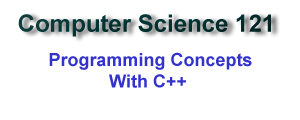|
Create a new C++ GUI project and name it
CS121HW2.
1. Create a text
file named "TomsInventory" in your solution and add 10 items (no
prices unless you want to show off!).
2. Add
a listbox, three
buttons, and three textboxes to your form.
3. Name the textboxes to txtFName, txtLName, &
txtItemPurchased. Add labels next to each textbox to show the user
what to do. Name the listbox "lbProducts".
4. Now, change the names of the buttons to
btnOK, btnClear, and btnQuit and change their text properties to OK,
Clear, and Quit.
5. Create
code to read each item in the disk file and add each item to the
listbox when your app starts up.
4. Write code in the SelectedIndex_Changed event
of the listbox. When they choose an item, display that item in the
txtItemPurchased textbox.
5. Create an event handler for the OK button.
When they click it, create a messagebox that says, "Thanks for
shopping (FirstName LastName). You
purchased a (Name of item)".
6. Write code to clear the form and put the
blinking cursor to the FName textbox.
7. Write code for the exit button to quit the
app.
|



